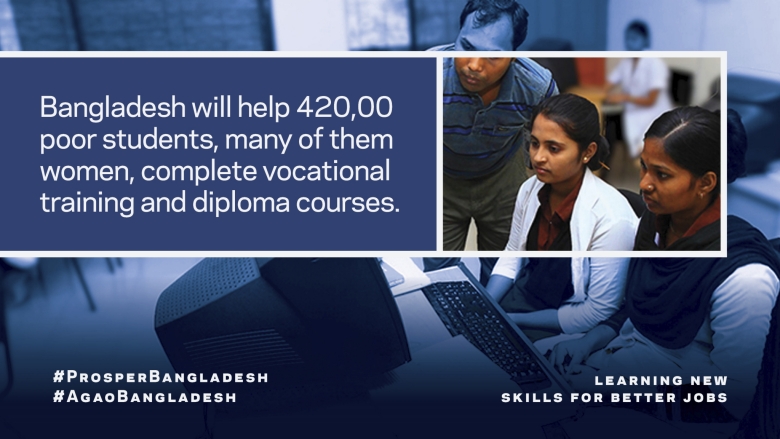Bangladesh downs India in WB’s human capital rankings

The World Bank Group unveiled a new system on Thursday to rank countries based on their success in developing human capital, an effort to prod governments to invest more effectively in education and healthcare.
The bank's "Human Capital Index," showed Bangladesh ahead of India and Pakistan, but one neighbour in South Asia shines brighter — Sri Lanka.
Poor African countries fared the worst in the rankings, with Chad and South Sudan taking the two lowest spots, while Singapore topped the list, followed by South Korea, Japan and Hong Kong, bdnews24.com reports.
The rankings, based on health, education and survivability measures, assess the future productivity and earnings potential for citizens of 157 of the World Bank's member nations, and ultimately those countries' potential economic growth.
WHAT IS THE STATE OF HUMAN CAPITAL IN BANGLADESH?
According to the Human Capital Index, a child born in Bangladesh today will be 48 percent as productive when she grows up as she could be if she enjoyed complete education and full health. That compares with 44 percent in India and 39 percent in Pakistan. Sri Lanka boasts 58 percent and Nepal 49 percent in the same category.
In the probability of survival, 97 out of 100 children born in Bangladesh survive to age 5, whereas it is 96 in India and 93 in Pakistan. Sri Lanka surpasses its neighbours with 99 out of 100 children surviving to age 5.
In Bangladesh, a child who starts school at age 4 can expect to complete 11 years of school by her 18th birthday. In India, a child can expect to complete 10.2 years of school in the same category, while it is 8.8 years in Pakistan. In Sri Lanka, a child who starts school at age 4 can expect to complete 13 years of school by her 18th birthday.
In harmonised test scores, students in Bangladesh score 368 on a scale where 625 represents advanced attainment and 300 represents minimum attainment. That puts Bangladesh behind Sri Lanka and Nepal. Students in Sri Lanka score 400, the highest in the region. It is 369 in Nepal and 355 in India, followed by Pakistan at 339.
In learning-adjusted years of school, factoring in what children actually learn, expected years of school is only 6.5 years in Bangladesh. That compares with 8.3 years in Sri Lanka, 5.8 years in India and 4.8 years in Pakistan.
Across Bangladesh, 87 percent of 15-year olds will survive until age 60 — an indicator that puts Bangladesh on par with Sri Lanka. This statistic is a proxy for the range of fatal and non-fatal health outcomes that a child born today would experience as an adult under current conditions.
Across India, 83 percent of 15-year olds will survive until age 60. Compared to India, it is slightly higher in Pakistan -- 84 percent. The rate is 85 percent in Nepal.
In terms of healthy growth (not stunted rate), 64 out of 100 children are not stunted in Bangladesh. And 36 out of 100 children are stunted, and so at risk of cognitive and physical limitations that can last a lifetime.
In India, 62 out of 100 children are not stunted; 38 out of 100 children are stunted, compared to 55 and 45 respectively in Pakistan.
The index was unveiled at the World Bank and International Monetary Fund annual meetings on the Indonesian island of Bali.
World Bank Group President Jim Yong Kim said he hoped the new index would encourage governments to take steps aimed at moving up the rankings, much as they seek to with the bank's popular "Doing Business" survey, which ranks countries based on ease of doing business, with low-tax, low regulation economies faring better.
Kim acknowledged that the rankings would be controversial, but told reporters that the need for more and better investment in people was "such that we couldn't shy away from making leaders uncomfortable".
"This is about drawing their attention to a crisis that we think is real. This is connected to productivity, this is connected to economic growth," Kim said.
He said there was "unanimous" acceptance among World Bank member countries and the bank's board.
The index measures the mortality rate for children under five, early childhood stunting rates due to malnutrition and other factors, and health outcomes based on the proportion of 15-year-olds who survive until age 60. It measures a country's educational achievement based on the years of schooling a child can expect to obtain by age 18, combined with a country's relative performance on international student achievement tests.
Countries in Africa with high childhood stunting rates and low access to formal education fared worst, while wealthier nations with strong educational systems fared best.
In Chad, the lowest country ranked on the list, the World Bank said productivity and earnings potential would be only about 29 percent of what their potential would be under ideal conditions there.
In top-ranked Singapore, the earnings potential was 88 percent of potential, while in the United States, ranked 24th between Israel and Macau, productivity and earnings were measured at 76 percent of potential.
Kim said there were 28 countries, from Indonesia to Lesotho to Ukraine, who signed on as "early adopters" of the index to work with the World Bank to devise plans to improve their investment in health and education.
The bank has warned that a wave of automation and artificial intelligence will eliminate many low-skilled jobs in coming years, making it harder for people with low levels of education and poor health to compete for work.
The index showed that a country ranked at 50 percent, such as Morocco and El Salvador, would lose 1.4 percentage points of annual GDP growth compared to its potential under ideal health and education conditions.
